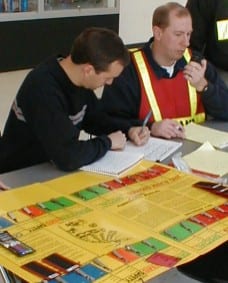 One of the primary purposes of a Personnel Accountability Report (PAR) is to ensure the incident commander and safety officer know where crews are and that all members are accounted for. In the event of a rapid change in conditions or an unforeseen turn of events, the PAR can be used to quickly account for what crews are intact and safe and what personnel may be endangered.
One of the primary purposes of a Personnel Accountability Report (PAR) is to ensure the incident commander and safety officer know where crews are and that all members are accounted for. In the event of a rapid change in conditions or an unforeseen turn of events, the PAR can be used to quickly account for what crews are intact and safe and what personnel may be endangered.
In addition to the reasons stated above, the PAR can also help improve commander and safety officer situational awareness as it relates to personnel wellness at an emergency scene.
The purpose of a PAR
A well-designed and conducted PAR dials the commander and safety officer in on every crew’s size, every crew’s location, and every crew’s progress (or lack of progress). Arguably, however, there may be an opportunity to make an incremental improvement in how PARs are conducted that will enhance command and safety situational awareness.
 Summertime can bring excessive heat and humidity to many regions. Wintertime can bring excessive cold and icy conditions to many regions. When weather is severe, first response personnel can be especially vulnerable to temperature-induced medical emergencies
Summertime can bring excessive heat and humidity to many regions. Wintertime can bring excessive cold and icy conditions to many regions. When weather is severe, first response personnel can be especially vulnerable to temperature-induced medical emergencies
As crews focus intently on their work, they may not realize how they are being impacted by excessive heat or cold.
In extreme weather conditions, a standard roll call PAR may not be sufficient if it is only designed to assess crew size, location, and task performance/progress. Crews suffering physically from the effects of heat or cold may find themselves affirming PAR without thinking about how the weather is impacting their stamina (and in some cases their decision-making abilities). And even if they are aware of how the weather is impacting them, a standard PAR may not provide a way for crews to tip command on their physical condition.
Dr. Gasaway’s advice
In extreme weather conditions give consideration to the possibility that the standard radio roll call PAR may not be adequate in assessing the physical well-being of personnel. When a crew acknowledges PAR, it speaks nothing to their welfare (physical condition or stamina).
Consider incorporating a procedure for the incident safety officers to conduct a “Walking PAR” and visually assess the well-being of responders with their own eyes (realizing this may not ALWAYS be possible with EVERY member).
Alternatively, where personnel is not visually observable, a PAR report could include a code that indicates the crew’s physical status. For example:
Green: Crew is in an excellent state of physical readiness.
Yellow: Crew has been actively performing high-stress tasks and has reduced stamina.
Red: Crew has been extensively performing high-stress tasks and has little stamina remaining.
 Think of it this way… the commander or safety officer is essentially asking crew members: “How much fuel is left in your gas tank.”
Think of it this way… the commander or safety officer is essentially asking crew members: “How much fuel is left in your gas tank.”
Command conducting a PAR using this coding system might hear a report that sounds like this:
Engine 101, PAR, crew of 4. Status green, second floor, attacking the fire.
Truck 302, PAR, crew of 4. Status 2 green, 2 yellow, the third floor conducting a search.
Squad 211, PAR, crew of 4. Status yellow, on the first floor conducting a search.
Engine 17, PAR, crew of 4. Status red, in staging.
In this example, there are 6 firefighters at full-stamina (status green), 6 firefighters running on half-stamina (status yellow), and 4 firefighters who are, essentially, out-of-service (status red).
Having a system to communicate the physical status of personnel (like color status coding) could tell the commander and safety officer a whole lot more about the physical/mental stamina of crews, improving command and safety situational awareness.
Action items
 Discuss the process your department uses to assess the physical well-being of personnel operating in high-stress, high-consequence environments.
Discuss the process your department uses to assess the physical well-being of personnel operating in high-stress, high-consequence environments.- Discuss ideas for how your department could ensure the well-being of personnel operating during periods of excessive weather?
- Discuss what systems your department could use, in addition (or in lieu of) a walking PAR or a status coding system, to assess responder well-being before their deteriorating physical stamina impacts operational safety.
About the Author
Richard B. Gasaway, PhD, CSP is widely considered a trusted authority on human factors, situational awareness and the high-risk decision making processes used in high-stress, high consequence work environments. He served 33 years on the front lines as a firefighter, EMT-Paramedic, company officer, training officer, fire chief and emergency incident commander. His doctoral research included the study of cognitive neuroscience to understand how human factors flaw situational awareness and impact high-risk decision making.
_____________________________________________________

If you are interested in taking your understanding of situational awareness and high-risk decision making to a higher level, check out the Situational Awareness Matters Online Academy.
CLICK HERE for details, enrollment options and pricing.
__________________________________
Share your comments on this article in the “Leave a Reply” box below. If you want to send me incident pictures, videos or have an idea you’d like me to research and write about, contact me. I really enjoy getting feedback and supportive messages from fellow first responders. It gives me the energy to work harder for you.
Let’s Get connected
Facebook: SAMatters
LinkedIn: Rich Gasaway
LinkedIn: Situational Awareness Matters
Twitter: Rich Gasaway
Youtube: SAMattersTV
itunes: SAMatters Radio
Stitcher Radio: SAMatters Radio
Google Play: SAMatters Radio
iHeart Radio: SAMatters Radio
